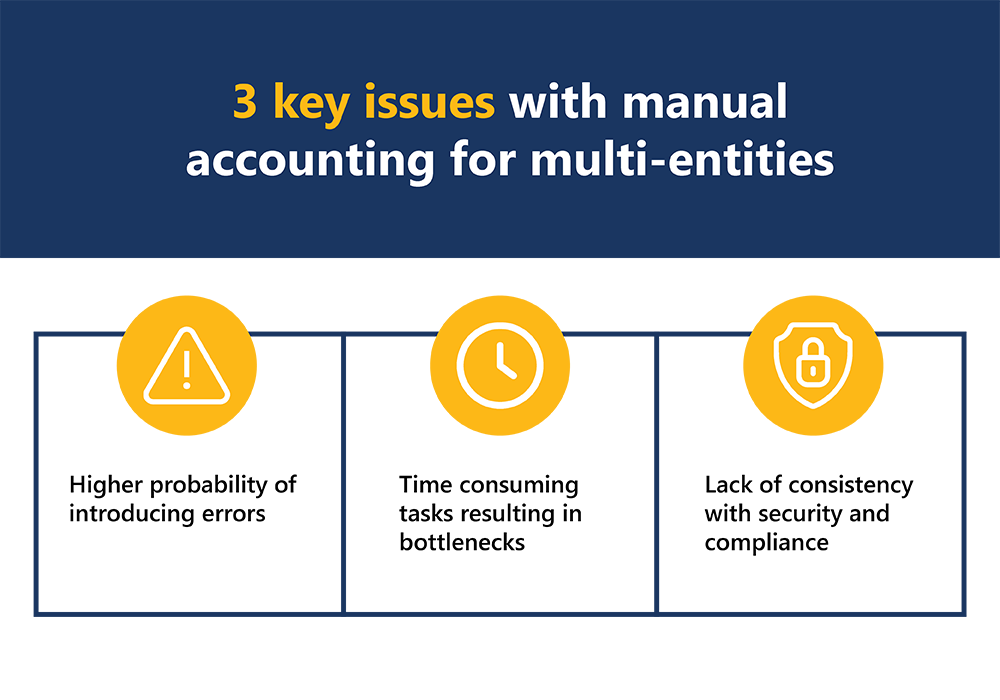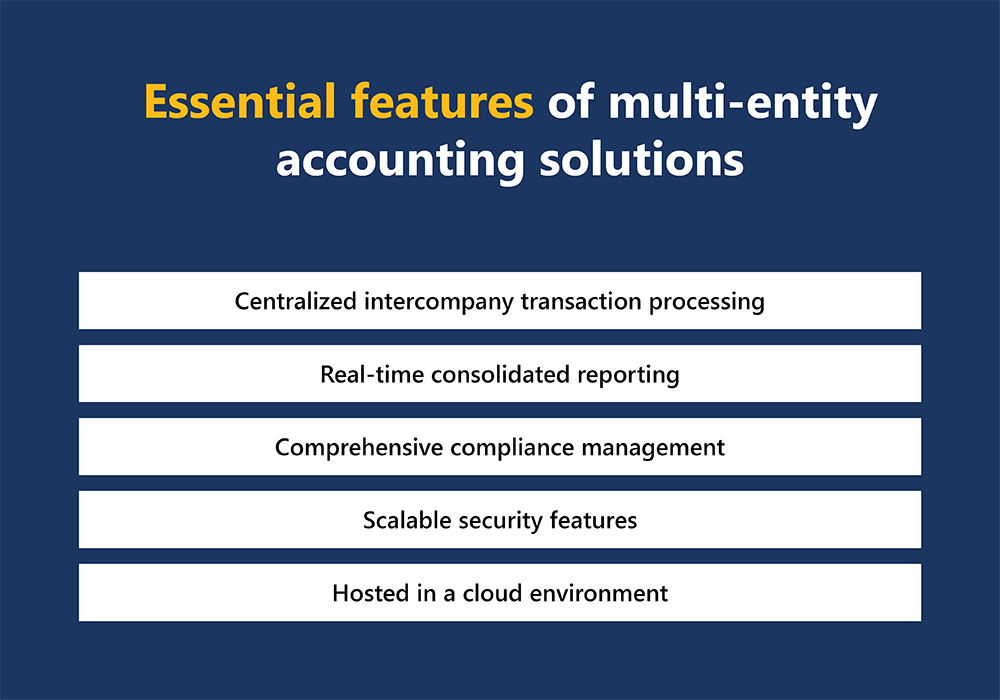Multi-entity accounting can be riddled with issues if you do not proactively scale your software with your growing company. Manual practices introduce a high risk for data errors, lengthy bottlenecks, security breaches, and non-compliance. By being fully embedded in Dynamics GP, Multi-Entity Management (MEM) provides real-time consolidated reporting, centralized transaction processing and a scalable security model without requiring users to learn a new system. Read on to learn how transforming your financial systems can help simplify your most tedious processes and reduce period-end headaches.
Why multi-entities struggle with financial consolidation
One of the essentials of multi-entity accounting is financial consolidation. It is required for all multi-companies under global accounting standards. Manual accounting practices for single entities will no longer work when applied to multi-companies for tasks such as period-end closing and reporting or maintaining regulatory compliance. Using software to automate these processes saves time and money while maintaining regulatory compliance and protecting you from security breaches.
When is it time to consider financial consolidation?
A multi-company business must consolidate when one company has majority voting power in another company (i.e. over 50% of the subsidiary’s outstanding common stock). Consolidation is also necessary if the parent company has minority ownership but exerts significant influence over the subsidiary’s business decisions.
A single company with various departments, segments, operating units, and regions may also be considered a multi-entity and need consolidated accounting if those units are treated as separate entities. If your company has added new entities through growth, acquisitions, or mergers, it may be time to consider financial consolidation.
Further reading for companies looking to consolidate:
- The ultimate post-merger financial consolidation checklist
- Multi-company financial consolidation FAQ
Why does manual accounting not work for multi-entities?
Manual accounting methods cannot keep pace with companies that have grown out of the start-up phase. As accounting increases in complexity, the likelihood of human errors increases as well. Failure to update accounting systems can create costly problems due to errors, wasted time and security leaks.
Higher probability of introducing errors
Links between spreadsheets could break, causing loss of function, improper back-ups could lead to the loss of critical data, and the likelihood of problems just increases with the number of people closing period-end across entities. With these kinds of problems, it can be an extensive undertaking just to figure out where the issue is coming from, let alone resolve it.
Multi-entity companies need to add additional companies and databases within an ERP to accommodate their growing structures. If this is done by manually managing separate data files and spreadsheets for consolidation, the resulting process becomes labour intensive and prone to errors. Common manual tasks such as copying the master records and chart of accounts from one company’s database to another are laden with risk for human errors.
For instance, links between spreadsheets could break, causing loss of function, and improper back-ups could lead to critical data loss. The likelihood of problems increases with the number of people closing period-end across entities. With these kinds of issues, it can be an extensive undertaking to figure out where the issue is coming from, let alone resolve it.
Recommended reading: How to improve data management for financial consolidation
Time consuming tasks resulting in bottlenecks
If you use email and spreadsheets to share information, manual entry and collaboration won’t happen in real-time. It can also introduce potential lag time in each stage of closing the accounting records for a period end.
Even after each entity has input their data, the head office for the parent company would need to log in and post entries for each entities’ accounting system and eliminate intercompany entries. Late entries or other adjustments at any point would further delay the process of closing for a period end. To complete these reports on time, some companies resort to hiring more people, which is an unnecessary expense compared to automated multi-entity accounting software.
Recommended reading: 4 best practices for handling intercompany transactions
Lack of consistency with security and compliance
Data leaks and non-compliance are significant risks that may result in hefty fines and penalties—complying with accounting standards like IFRS 10 and ASC 810 is crucial to any company’s scalable growth. Although it’s common for security breaches of some kind to occur, you don’t want security breaches to become standard for your company.
There’s a high risk of a data breach when you’re transferring reports and sensitive information between multiple systems. Manual accounting practices exacerbate these concerns because the data is decentralized, and strict maintenance of each system is required to withstand cyber threats.
A centralized ERP built to manage the demands of financial consolidation will not only centralize and bolster your data against security issues but will also reduce the risk of non-compliance.
Recommended reading: 5 simple ways an ERP system improves compliance for your company

What to look for in multi-entity accounting solutions
Dynamics GP on its own is not built to handle the complexity of multi-companies; however, there are solutions that can fully integrate to augment its functionality so that multi-companies do not have to look for a new ERP system. Companies should focus on core features that enable compliance and a consolidated financial statement without running into the above issues/challenges.
Processing intercompany transactions can take weeks and involves a ton of redundant, repetitive tasks required by the accounting team. A centralized environment for intercompany transaction processing can be a huge benefit. This feature allows intercompany transactions to happen in an instant, even across multiple entities, and grants complete insight into historical transactions.
Month-end reports and consolidated financial statements can also take weeks to complete without proper software. Look for solutions offering real-time consolidated reporting, this feature will allow your company to have access to actionable insights about performance throughout the process and far faster than before. It also enables enhanced data integrity and accuracy because it manages a single set of master records.
There are costly penalties if you cannot prove compliance with global accounting standards, including the risk of losing company licences in severe cases. Security breaches can likewise incur expensive fines. It’s best to avoid the hassle and prioritize comprehensive compliance management and a rigorous security setup as requirements of any software you choose to invest in. Bonus points if the security features are scalable and include SSL encryption, two-factor authentication, advanced firewalls and automated notifications for new sign-ins.
Additionally, software that exists in the cloud gives you the ability to tap into the database from any location, which can be especially useful for parent companies that need insight into their subsidiaries. It also cuts the cost of having to maintain and upgrade on premise servers.
Recommended reading: 6 essential financial consolidation software features for your company

How MEM fills the gaps in Dynamics GP
To get the most out of Microsoft Dynamics GP as a multi-entity we recommend investing in Multi-Entity Management (MEM). MEM can be deployed in the cloud, in a hosted environment, or on-premises and includes essential features of any accounting software you may be considering. MEM offers real-time consolidated reporting, so you can gain better insights and remain up to date on your performance with flexible reports across all your companies or business units, centralized transaction processing, which permits multiple legal entities to be in a single transaction with proper allocations and reporting, comprehensive compliance management, and a scalable security set up, so that you never have to pay the price of being caught off guard. We also offer friendly customer service and comprehensive training to make the transition as smooth as possible.


